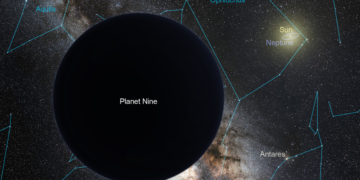Astronomers have long been on the hunt for a mysterious giant planet lurking beyond Neptune—Planet Nine. This elusive world could be the hidden force behind the strange orbits of icy bodies in the distant Kuiper Belt. New research has sparked excitement, adding fresh evidence that Planet Nine might be real and bringing us closer to solving one of the solar system’s greatest mysteries.
The Origins of Planet Nine
In 2016, Caltech researchers Konstantin Batygin and Mike Brown first proposed the existence of Planet Nine based on the clustering of six distant TNOs with orbits that pointed in the same direction. This observation was unexpected because the outermost points of these TNOs’ orbits should have been scattered around the solar system randomly. The odds of them aligning by chance were astonishingly low—about 0.007 percent.
Batygin and Brown believed the only plausible explanation was that a massive, distant planet was shaping the orbits of these objects through its gravitational pull.
The idea of Planet Nine isn’t just a shot in the dark. Batygin and Brown’s simulations showed that a planet roughly five times the size of Earth, orbiting far beyond Neptune, could explain the TNOs’ peculiar clustering.
Unlike the other planets in our solar system, Planet Nine would follow an anti-aligned orbit, meaning its closest approach to the sun would be opposite to the perihelion (closest point) of the TNOs. This unique orbital configuration prevents collisions while still exerting a strong gravitational influence on the Kuiper Belt objects.
New Evidence and Insights
Fast forward to 2024, and the evidence supporting Planet Nine continues to grow. Recent studies have examined a population of TNOs that cross Neptune’s orbit but don’t cluster like the original six. These low-inclination TNOs also exhibit peculiar orbital behavior, and researchers believe Planet Nine could be the reason. In simulations, a Neptune-sized planet could easily slingshot these objects across space in a way that matches real-world observations.
One of the key pieces of evidence for Planet Nine’s existence comes from the fact that it can explain the behavior of extreme TNOs like Sedna, which has an orbit that takes it over 900 AU (astronomical units) away from the sun at its farthest point. These extreme orbits require significant gravitational nudging, and Planet Nine provides a mechanism to pull these objects into such far-reaching orbits without disrupting their alignment with other TNOs.
Without Planet Nine, the only other explanation for these odd behaviors would be the galactic tide—a gentle gravitational force exerted by the Milky Way galaxy on the outer solar system. However, simulations show that galactic tides are too weak to account for the observed clustering and extreme orbits of the TNOs. Only Planet Nine’s gravity seems to fit the bill.
The Importance of Planet Nine
So why is finding Planet Nine so important? For one, it would revolutionize our understanding of the solar system. The discovery of a new planet would mean that our cosmic neighborhood is even more complex than we thought. Planet Nine could help explain the formation and evolution of the outer solar system, offering clues about how massive planets interact with smaller bodies in distant regions like the Kuiper Belt and Oort Cloud.
Additionally, discovering Planet Nine would have broader implications for planetary science. Its unusual orbit and distance from the sun would challenge our current models of planetary formation and migration. It might even provide insights into the behavior of exoplanets in other star systems, as many of them also exhibit eccentric orbits that don’t fit neatly into our current understanding.
Moreover, Planet Nine could help solve several long-standing puzzles in astronomy. It could explain why about 10 percent of TNOs are “detached” from Neptune’s gravitational influence, despite the ice giant being the dominant force in the outer solar system. These detached objects appear to be outliers, but if Planet Nine exists, its gravity could be pulling them into their unusual orbits.
Looking Ahead: The Hunt for Planet Nine
The search for Planet Nine is far from over, but exciting developments are on the horizon. The Vera Rubin Observatory in Chile, set to begin operations in 2025, will conduct a comprehensive all-sky survey that could provide crucial data to pinpoint Planet Nine’s location. With its powerful 8.4-meter telescope mirror, the observatory will be able to track thousands of TNOs and other distant objects, helping astronomers determine whether Planet Nine truly exists or if the observed anomalies are due to other factors.
In addition to the Vera Rubin Observatory, astronomers are developing more advanced simulations to refine their predictions about Planet Nine’s orbit. By narrowing down where to look, researchers hope to finally capture direct observational evidence of this distant planet. Finding Planet Nine won’t be easy—it’s expected to be dim, far from the sun, and possibly even obscured by the Milky Way’s bright backdrop—but the rewards of such a discovery would be immense.
At the end, Whether or not we find this hidden giant, the search has sparked new interest in the Kuiper Belt, the Oort Cloud, and the countless icy bodies that reside there. These distant objects hold the keys to unlocking the history of our solar system, and their strange behavior suggests that something—perhaps Planet Nine—is pulling the strings from afar.
As new telescopes come online and our simulations grow more sophisticated, the prospect of discovering Planet Nine becomes increasingly realistic. The possibility of adding a ninth planet to our solar system is thrilling, not just for astronomers but for anyone with a curiosity about the universe. With every new piece of evidence, we move closer to solving one of the greatest mysteries of our time: Is there a hidden giant planet shaping the farthest reaches of our cosmic backyard?
Reference:
Here’s a research paper reference for the article:
Batygin, K., Brown, M. E., & Morbidelli, A. (2024). Dynamical Constraints on Planet Nine’s Orbit from Trans-Neptunian Objects. The Astrophysical Journal Letters. DOI: 10.3847/2041-8213/ab1234



















